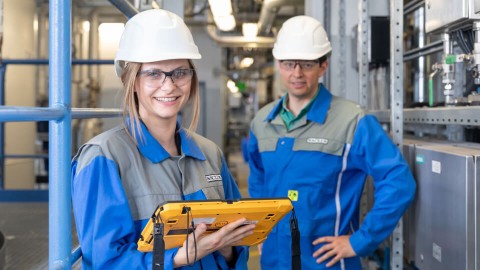VINNAPAS® 754 ED

VINNAPAS® 754 ED is a construction dispersion for two-component dry mix mortars, specifically suited for cement admixtures and two-component cementitious waterproofing membranes. VINNAPAS® 754 ED belongs to the product class VINNAPAS® ED. It is based on a highly flexible terpolymer of vinyl acetate, ethylene and vinyl ester and enhances therefore adhesion and flexibility of mortars.
The product is in the operational implementation phase (scale-up product). Therefore, the currently specified product data still can change. Prior to industrial use, availability requires clarification with WACKER POLYMERS.
特性
- VINNAPAS® 754 ED is an aqueous dispersion of vinyl acetate, ethylene and vinyl ester terpolymer with a 55 ± 1% solids content.
- The dispersion is produced without the use of plasticizers.
- VINNAPAS® 754 ED is particulary suited for modifying mineral mortars. It improves the adhesion to inorganic and organic substrates, as well as abrasion resistance und crack-bridging capability.
- VINNAPAS® 754 ED combines excellent adhesion and very good flexibility with verygood compatibility to inorganic binders such as ordinary Portland cement and high alumina cement.
Two-Component waterproofing membranes, primers & cement admixes are the most important applications for VINNAPAS® 754 ED. In these applications VINNAPAS® 754 ED improves adhesion, abrasion resistance and flexural strength. For enhanced compressive and flexural strength, we recommend adding a suitable defoaming agent or modifying the dry component with a powder defoamer.
For further information regarding applications of VINNAPAS® 754 ED, refer to the section "Application". Please discuss additional applications with your WACKER customer representative.
Processing:
VINNAPAS® 754 ED can be blended with most VINNAPAS® dispersions and many other aqueous polymer dispersions in any ratio. When blending, it is important to adjust the pH of both dispersions which are to be blended in a pH range in which both dispersions are stable. Storage tests should be carried out to check the compatibility of the mixture.
包装
Non-returnable PE drums of 150 kg capacity (standard dispatch quantity: only fully-loaded pallets à 750 kg), and non-returnable containers of 1 t capacity.
储存
When the dispersion is stored in tanks, proper storage conditions must be maintained. The product has a shelf life of 6 months starting from the date of receipt if stored in the original, unopened containers at temperatures between 5 and 30 °C. Any longer periods for the maximum storage period that may be described in the Certificate of Analysis which accompanies each shipment of the product, take preference over this suggestion in which case the time period stated in the Certificate of Analysis shall be solely authoritative. Iron or galvanized iron containers and equipment are not recommended. Corrosion could result in discoloration of the dispersion or blends made from it in further processing. We therefore recommend the use of containers and equipment made of ceramic, rubberized or enameled materials, appropriately finished stainless steel, or plastic (rigid PVC, polyethylene or polyester resin). As polymer dispersions may tend to superficial film formation, skins or lumps may be formed during storage or transportation. A filtration process is thus recommended prior to utilization of the product.
Preservation for Transport, Storage and further Processing
The product is adequately preserved during transportation and storage if kept in the original, unopened containers. However, if it is transferred to storage tanks, the dispersion should be protected against microbial attack by adding a suitable preservative package.
Measures should also be taken to ensure cleanliness of the tanks and pipes. In unstirred tanks, a layer of preservative-containing water should be sprayed onto the surface of the dispersion to prevent the formation of unwanted skin and possible attack by microorganisms. The thickness of this water layer should be < 5 mm for low viscosity dispersions and up to 10–20 mm for high viscosity products. Proper procedures – periodic tank cleaning and sanitization – must be set up in order to prevent microbial attack. Contact your biocide representative/supplier for further plant hygiene recommendations. Measures should be taken to ensure that only clean air enters the tank when the dispersion is removed.
Finished products manufactured from polymer dispersions usually also require preservation. The type and scope of preservation will depend on the raw materials used and the anticipated sources of contamination. The compatibility with other components and the efficacy of the preservative should always be tested in the respective formulation. Preservative manufacturers will be able to advise you about the type and dosage of preservative required.
销售和支持
200233 Shanghai
中国
+86 21 6130-2500 (传真)
经销商
未找到销售本产品的经销商


